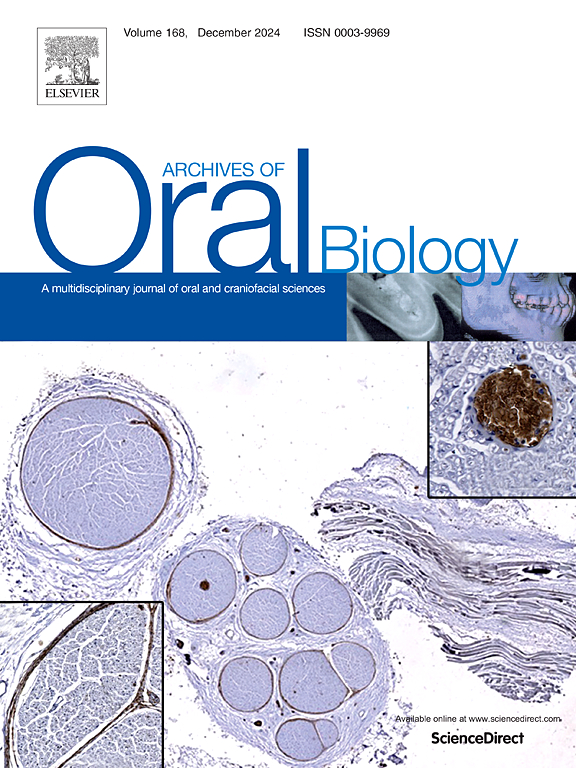The salivary and GCF AGE/sRAGE-IL-17 axis in periodontitis and diabetes: A pathophysiological perspective on disease progression and inflammation
IF 2.1
4区 医学
Q2 DENTISTRY, ORAL SURGERY & MEDICINE
引用次数: 0
Abstract
Objective
Diabetes, if uncontrolled, increases the risk of periodontal disease and associated tooth loss. While AGE and sRAGE levels have been explored in diabetes, their role in localized inflammation in periodontium is poorly understood. The aim of this study was to investigate AGE/sRAGE ratio and IL-17 in saliva&gingival crevicular fluid in the presence of periodontitis in diabetic patients which may underlie disease development or progression.
Design
This cross-sectional study included 64 patients, divided into 4 groups as healthy (H), periodontitis without diabetes(P), periodontitis patients with controlled diabetes(DP), periodontitis patients with poorly controlled diabetes(PDP). Periodontal clinical parameters were recorded. AGE, sRAGE, IL-17 levels in GCF and saliva samples were measured with ELISA and AGE/sRAGE ratio was determined.
Results
GCF AGE/sRAGE ratio and IL-17 levels of periodontitis groups were significantly higher than H group, while sRAGE levels were significantly lower (p < 0.05). In addition, AGE/sRAGE ratio of PDP group were significantly higher than DP group in GCF and saliva (p < 0.05). ROC curve analysis showed significantly discriminative performance of the parameters in both GCF and saliva. HbA1c levels were positively correlated with AGE/sRAGE ratio in GCF and saliva(p < 0.05).
Conclusions
This study demonstrated that GCF and salivary biomarkers, particularly IL-17 and AGE/sRAGE ratio, may have diagnostic potential in distinguishing periodontal disease severity in relation to glycemic status. ROC analysis supported the discriminative ability of these markers, especially in GCF, with satisfactory sensitivity and specificity. The AGE/sRAGE ratio in both GCF and saliva showed promise as a non-invasive biomarker, especially in patients with poorly controlled diabetes.
牙周炎和糖尿病患者的唾液和GCF AGE/ sage - il -17轴:疾病进展和炎症的病理生理学视角
糖尿病如果不加以控制,会增加牙周病和相关牙齿脱落的风险。虽然AGE和sRAGE水平已经在糖尿病中得到了探讨,但它们在牙周组织局部炎症中的作用却知之甚少。本研究的目的是调查糖尿病患者牙周炎患者唾液和龈沟液中AGE/sRAGE比值和IL-17,这可能是疾病发生或进展的基础。设计本横断面研究纳入64例患者,分为健康(H)、无糖尿病牙周炎(P)、糖尿病控制牙周炎(DP)、糖尿病控制不佳牙周炎(PDP) 4组。记录牙周临床参数。ELISA法测定GCF和唾液中AGE、sRAGE、IL-17水平,并测定AGE/sRAGE比值。结果牙周炎组gcf AGE/sRAGE比值及IL-17水平显著高于H组,sRAGE水平显著低于H组(p <; 0.05)。GCF和唾液中,PDP组的AGE/sRAGE比值显著高于DP组(p <; 0.05)。ROC曲线分析显示GCF和唾液的参数具有显著的判别性。HbA1c水平与GCF和唾液中AGE/sRAGE比值呈正相关(p <; 0.05)。本研究表明GCF和唾液生物标志物,特别是IL-17和AGE/sRAGE比值,可能在区分牙周病严重程度与血糖状态的关系方面具有诊断潜力。ROC分析支持这些标记的鉴别能力,特别是在GCF中,具有令人满意的敏感性和特异性。GCF和唾液中的AGE/sRAGE比值显示出作为一种非侵入性生物标志物的前景,特别是在糖尿病控制不良的患者中。
本文章由计算机程序翻译,如有差异,请以英文原文为准。
求助全文
约1分钟内获得全文
求助全文
来源期刊

Archives of oral biology
医学-牙科与口腔外科
CiteScore
5.10
自引率
3.30%
发文量
177
审稿时长
26 days
期刊介绍:
Archives of Oral Biology is an international journal which aims to publish papers of the highest scientific quality in the oral and craniofacial sciences. The journal is particularly interested in research which advances knowledge in the mechanisms of craniofacial development and disease, including:
Cell and molecular biology
Molecular genetics
Immunology
Pathogenesis
Cellular microbiology
Embryology
Syndromology
Forensic dentistry
 求助内容:
求助内容: 应助结果提醒方式:
应助结果提醒方式:


